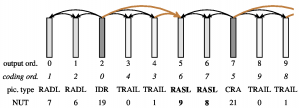 HEVC comprises a large number of different picture types. The picture types are indicated in the NAL unit headers of the NAL units carrying the slices of the pictures. Thereby, essential properties of the NAL unit payload is available at a very high level for use by applications.
HEVC comprises a large number of different picture types. The picture types are indicated in the NAL unit headers of the NAL units carrying the slices of the pictures. Thereby, essential properties of the NAL unit payload is available at a very high level for use by applications.
The picture types include the following:
- Random access point pictures, where a decoder may start decoding a coded video sequence. These are referred to as Intra Random Access Pictures (IRAP). Three IRAP picture types exist: Instantaneous Decoder Refresh (IDR), Clean Random Access (CRA), and Broken Link Access (BLA). The decoding process for a coded video sequence always starts at an IRAP.
- Leading pictures, which precede a random access point picture in output order but are coded after it in the coded video sequence. Leading pictures which are independent of pictures preceding the random access point in coding order are called Random Access Decodable Leading pictures (RADL). Leading pictures which use pictures preceding the random access point in coding order for prediction might be corrupted if decoding starts at the corresponding IRAP. These are called Random Access Skipped Leading pictures (RASL).
- Trailing pictures, which follow the IRAP and the leading pictures in both, output and display order.
- Pictures at which the temporal resolution of the coded video sequence may be switched by the decoder: Temporal Sublayer Access (TSA) and Stepwise Temporal Sublayer Access (STSA)
The figure shows a coding structure with random access points, as well as leading and trailing pictures (illustrative example, not a recommended structure).